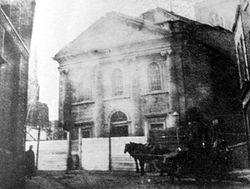- Church of St. John the Evangelist, Dublin
-
Church of St. John the Evangelist 
The church shortly before its demolition in 1884.Coordinates: 53°20′38″N 6°16′31″W / 53.34389°N 6.27528°W Location Fishamble Street, Dublin Country Ireland Denomination Church of Ireland History Former name(s) St. John de Bothestret (1327) Founded 1168 Founder(s) Giolla Michell Dedication St. John the Evangelist Architecture Closed 1878 Demolished 1884 Administration Province Province of Dublin The Church of St. John the Evangelist was a former Church of Ireland church located on the west side of Fishamble Street in the centre of Dublin, Ireland. It was founded in the 12th century, and a great many of its parish records survive.
Contents
The Church
According to Sir John Gilbert the church was built in 1168 by a native Irishman called Giolla Michell.[1] It was then attached to the Church of the Most Holy Trinity (Christ Church), which was run by the Augustinian Order. Fishamble St. in those times reached only as far as the Music Hall, the rest, where the church was located, was called Bothestret. In the church there was a chapel to St. Mary and one to St. John, which was used by the Guild of Tailors.[2]
In the 14th century at Easter a Miracle Play, on the subject of the Resurrection, was performed in the church.[3]
An Arland Ussher (died 1557), nephew of the Mayor of Dublin, rebuilt the church. The new church consisted of a chancel, nave and two aisles. There were vaults underneath the church and a belfry contained three bells.[4]
The church was re-built in 1681. Its walls were only 24 feet (7.5 meters) high. There were 42 pews, which were shared among several families. The names Bladen, Hutchinson, Forster, Crumpe, Crossart, Thompson, Grimes, Reeves, Stacey and Shipley, among others, are recorded.
In the mid 18th-century a committee was formed to raise funds for yet another renovation of the church. They were successful in raising thousands of pounds from the government and smaller sums from other sources, so that the church was rebuilt and re-opened in 1773. The pews were auctioned to the highest bidders, providing those with the most money with the best seats. Alderman Robert Smith contributed funds to buy an organ, from William Gibson of Grafton St., but unfortunately it never worked properly.
The church was closed in 1878, after the parish was united with that of St. Werburgh. The pulpit and other pieces were taken to that church.
The churchyard
There was a graveyard attached to the church; the first tombstone mentioned is that of William Scriven, in 1681. Many titled people, aldermen, sheriffs, members of parliament, lawyers, clergy, lord mayors, and scholars were buried there. The last mentioned is that of Elizabeth Frances McAusland in 1850. It is estimated that there were more than 12,500 burials in total.[5]
The parish
The parish, which covered the area around the now closed Catholic church of St. Michael and John, was a union of two: St. John's and St. Olaf's. The latter, founded in the first half of the 11th century, commemorated Olaf I, King of Norway, and its church was located in what is present-day Essex St. The parishes were formally united in 1558.[6] The parish corresponded with the civil parish of St. John.
Notable parishioners
In 1748, Thomas Sheridan paid for a pew for the use of his players in the Smock Alley theatre.[7] In 1746, Henry Grattan was born nearby and baptised at this church.[8] The writer John Duncan Craig was curate here in the mid-1850s.
References and sources
- Notes
- ^ Gilbert (1854)
- ^ Hughes, p. 18
- ^ Dublin Theatrics
- ^ Hughes, p. 22
- ^ Dublin's burial grounds and graveyards, by Vivien Igoe. Wolfhound, Dublin, 2001
- ^ Hughes, p. 13
- ^ Hughes, p. 28
- ^ Distinguished Dubliners
- Sources
- Gilbert, John (1854). A History of the City of Dublin. Oxford: Oxford University. http://www.chaptersofdublin.com/books/Gilbert/gilbert2.htm.
- George Newenham Wright (last modified 2005). "An Historical Guide to the City of Dublin". Online book. http://www.chaptersofdublin.com/books/Wright/wright10.htm. Retrieved 2008-11-02.
- Samuel Carlyle Hughes The Church of S. John the Evangelist, Dublin, Dublin, 1889. Reprinted by Kessinger Publishing, 2009.
Categories:- 1878 disestablishments
- Church of Ireland Parishes and Churches in the Republic of Ireland
- Former churches in the Republic of Ireland
- 12th-century church buildings
- Churches in Dublin (city)
Wikimedia Foundation. 2010.
